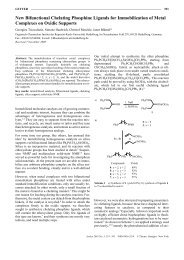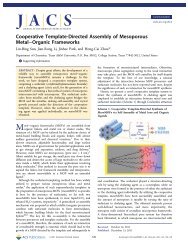02/10/11 - Department of Chemistry
02/10/11 - Department of Chemistry
02/10/11 - Department of Chemistry
You also want an ePaper? Increase the reach of your titles
YUMPU automatically turns print PDFs into web optimized ePapers that Google loves.
HIGHLIGHT<br />
Development <strong>of</strong> DSM's Hybrane® Hyperbranched<br />
Polyesteramides<br />
PEER FROEHLINC<br />
R&D <strong>Department</strong>, DSM Hybrane BV, PO Box 18, Celeen 6160 MD, the Netherlands<br />
Received 12 February 2004; Accepted 17 February 2004<br />
DO1: <strong>10</strong>.<strong>10</strong><strong>02</strong>/po1a.20<strong>11</strong>3<br />
Published online in Wiley InterScience (www.interscience.wiley.com).<br />
ABSTRACT: The development<br />
<strong>of</strong> DSM ' s Hybrane* hyperbranched<br />
polyfester amides) is described.<br />
The monomer (1) for the<br />
hyperbranched polyester is obtained<br />
from the reaction <strong>of</strong> a cyclic<br />
anhydride with diisopropanol<br />
amine, yielding a tertiairy amide<br />
with one COOH and two OH<br />
PEER FROEHXING<br />
Correspondence to: P. Froehling (E-mail: peerfroehling@<br />
groups. Poly condensation takes<br />
place via an oxazolinium intermediate<br />
in bulk at relatively mild conditions<br />
in the absence <strong>of</strong> catalyst.<br />
The reaction has been scaled up to<br />
ton scale. By varying and combining<br />
anhydrides, and modification<br />
with several types <strong>of</strong> end groups, a<br />
large variety <strong>of</strong> structures with<br />
concomitant properties and industrial<br />
applications has been realized.<br />
C 2004 Wiley Periodicals. Inc. J Polym Sci<br />
Pan A: Polym Oiem 42: 31<strong>10</strong>-3<strong>11</strong>5,2004<br />
Keywords: hyperb ranched; dendnmers;<br />
poly condensation; polyesters<br />
Peter E. ("Peer") Froehling, born 1949, works as Application Development<br />
Manager for DSM Hybrane, a startup daughter company <strong>of</strong> DSM<br />
Venturing and Business Development. He studied chemistry at the Technical<br />
University <strong>of</strong> Eindhoven, and obtained a Ph.D. in biomedical<br />
materials science at the University <strong>of</strong> Twente. In 1977, he joined DSM's<br />
research laboratories in Geleen, the Netherlands, where he has been<br />
involved in a broad variety <strong>of</strong> polymer-related research activities such as<br />
thermosets, morphology, molecular imprinting, preceramic and conductive<br />
polymers, and (since 1995) application development <strong>of</strong> dendrimers<br />
and hyperbranched polymers. He is (co)aulhor <strong>of</strong> about 35 scientific<br />
papers and 15 patent applications. His extracurricular interests include<br />
hiking (on relatively horizontal surfaces), opera, genealogy, and playing<br />
the viola.<br />
42.31<strong>10</strong>-3<strong>11</strong>5(2004)<br />
INTRODUCTION<br />
Dendritic macromolecules (i.e., dendrimers and hyperbranched<br />
polymers) have already been the subject <strong>of</strong><br />
many <strong>of</strong> these Highlights. Some earlier authors are Kim1<br />
(research activities at DuPont), Voir (a broad overview<br />
<strong>of</strong> the chemistry <strong>of</strong> hyperbranched systems), and Tomalia<br />
and Frechet3 (history <strong>of</strong> dendrimers). In this Highlight,<br />
J want to show how the development <strong>of</strong> Hybrane*<br />
hyperbranched polyesteramides was first inspired by the<br />
success <strong>of</strong> our Astramol poly(propylene imine) dendrimers,4<br />
and how it evolved into the realization <strong>of</strong> a large<br />
variety <strong>of</strong> new structures and properties. This has ultimately<br />
led to a series <strong>of</strong> industrial applications lhat make<br />
use <strong>of</strong> the unique properties <strong>of</strong> dendritic structures such<br />
as the lack <strong>of</strong> entanglements, the large number <strong>of</strong> reactive<br />
end groups, and the possibility to interact with guest<br />
molecules.<br />
FIRST STEPS AND BREAKTHROUGH<br />
Within DSM, dendritic molecules had from the beginning<br />
a special attraction for researchers in the coating<br />
resins area. Their high functionality, combined with their<br />
low viscosity due to the absence <strong>of</strong> entanglements,<br />
should make dendrimers or dendrimer-like molecules a<br />
very useful new type <strong>of</strong> crosslinker in, for example.<br />
powder coatings. However, the production <strong>of</strong> dendrimers<br />
would always be relatively costly because <strong>of</strong> the required<br />
large number <strong>of</strong> consecutive steps needed either in convergent<br />
or divergent syntheses. In an application field<br />
that is largely cost-driven, the use <strong>of</strong> dendrimers seemed<br />
therefore prohibitively expensive, and an alternative in<br />
the form <strong>of</strong> hyperbranched macromolecules would be<br />
much more attractive. Therefore, the hunt for hyperbranched<br />
polymers was opened in 1994 by Ton<br />
Loontjens, then manager <strong>of</strong> DSM's coatings research<br />
department in Geleen. The practical development <strong>of</strong> hyperbranched<br />
polymers based on Flory's AB-> concept3<br />
(Fig. 1) had started only a few years earlier. What still<br />
was missing, however, was an AB2 monomer based on<br />
low-cost chemistry and technology, a conditio sine qua<br />
non for coalings applications.<br />
Ton and his coworker Dirk Stanssens rapidly came up<br />
with a list <strong>of</strong> ideas for commercially attractive AB-,<br />
chemistries. Dirk had already done fundamental work on<br />
0-hydoxyalkyl-amides,6 a class <strong>of</strong> compounds that possesses<br />
a highly increased esterification rate with carboxylic<br />
acids whereby the formation <strong>of</strong> an oxazolinium<br />
intermediate has a key role (Fig. 2).<br />
It seemed logical to use this type <strong>of</strong> reactant, already<br />
known in coatings chemistry, to make hyperbranched<br />
polyesters. Dirk's idea was to make an AB-, monomer by<br />
HIGHLIGHT 3U1<br />
Figure 1. AB2 polycondensation as described by<br />
Florys leads to a hyperbranched macromolecule.<br />
the reaction between a cyclic (e.g., phthalic) anhydride<br />
and diethanolamine (DEA), which both are economically<br />
very attractive starting materials. The polycondensation<br />
<strong>of</strong> this product via an oxazolinium intermediate would<br />
then lead to a hyperbranched polyesteramide without the<br />
need <strong>of</strong> catalysis or high temperatures (Fig. 3). Moreover,<br />
for the intended coating resins application, it was<br />
necessary to have a solvent-free product, which logically<br />
led to the idea to conduct the monomer synthesis and the<br />
subsequent polymerization to a hyperbranched polymer<br />
in a one-pot solventless reaction system.<br />
Unfortunately, the first experiments with phthalic anhydride<br />
and DEA only led to strongly discolored, partially<br />
crosslinked, or even gelled products, not at all what<br />
eventually might become an acceptable material for coating<br />
applications. Another problem was the inherent lack<br />
<strong>of</strong> molecular weight control in the AB, polymerization.<br />
The breakthrough that made it eventually possible to<br />
develop an industrially viable route to hyperbranched<br />
poly(ester amides) came in 1996. It was accomplished by<br />
Rolf van Benthem, who had recently joined DSM's<br />
coating research team at Geleen. He found that the cause<br />
<strong>of</strong> the gelation was an undesired side product from the<br />
reaction <strong>of</strong> the OH group <strong>of</strong> the DEA instead <strong>of</strong> the<br />
amine group The remaining secondary amine in the<br />
formed ester would not only lead to extensive discoloration,<br />
it could also react with the cyclic anhydride yielding<br />
a A2B reactam that would rapidly lead to an undesired<br />
crosslinking <strong>of</strong> the whole system. Rolf first proposed<br />
to replace DEA by diisopropanolamine (DiPA),<br />
which through the diminished reactivity <strong>of</strong> its secondary<br />
hydroxyl group would suppress the side reaction in favor<br />
<strong>of</strong> the reaction <strong>of</strong> its amine with the anhydride (Fig. 3).<br />
Next, he also introduced the use <strong>of</strong> an excess <strong>of</strong> DiPA to<br />
control the molecular weight <strong>of</strong> the formed polymer.<br />
Another idea was to make modified polymers by esterification<br />
<strong>of</strong> the OH end groups by (partial) esterification<br />
with added mon<strong>of</strong>unctional carboxylic acids. This gave<br />
an additional control <strong>of</strong> the molecular weight (typically
3<strong>11</strong>2 J. POLYM. SCI. PART A: POLYM. CHEM: VOL. 42 (2004)<br />
0 ",<br />
R^-t-i-c<br />
R,—H—N—CHj-CHj-O—(!—R,<br />
Figure 2. Reaction <strong>of</strong> a 0-hydroxyalkylamide (1) with a carboxylic acid leads to esters (3) via an oxazolir<br />
intermediate (2) without the use <strong>of</strong> catalysts, as discovered by Stanssens.6 R,, R.^, R$ = alky] or aryl.<br />
in the range <strong>10</strong>00-<strong>10</strong>.000), and also yielded products<br />
with an improved flow and (by using, e.g., oieic acid)<br />
air-drying properties for use in combination with alkyd<br />
resins. Soon it turned out that these modifications <strong>of</strong> the<br />
original concept indeed made it possible to have full<br />
control over the system, and to make reproducible products<br />
even at a much larger scale7 (Fig. 4).<br />
STRUCTURES AND PROPERTIES<br />
Very soon we became aware <strong>of</strong> the fact that the chemistry<br />
described above could yield a much broader variety<br />
<strong>of</strong> products. Not only choosing different cyclic anhydrides<br />
or end groups, but especially also combining<br />
different elements in one molecule should lead to a<br />
virtually endless lisi <strong>of</strong> structures. This principle would<br />
give us the possibility to fine-tune the product's properties<br />
toward all kinds <strong>of</strong> applications, certainly also outside<br />
the coating resins area.<br />
One <strong>of</strong> the properties we could control by choosing<br />
the appropriate combination <strong>of</strong> anhydrides and end<br />
groups was solubility. Initially, we found that most hydroxy-terminated<br />
base resins were soluble in a large<br />
variety <strong>of</strong> solvents, with water and hydrocarbons as<br />
notable exceptions on the edges <strong>of</strong> the polarity spectrum.<br />
Only resins made with succinic anhydride turned out to<br />
be water soluble (Fig. 5).<br />
Next, it was found that succinic-based resins could<br />
tolerate reasonable amounts <strong>of</strong> other anhydride building<br />
blocks or end groups such as acetate, benzoate, or even<br />
fatty acid esters, and still remain soluble in water. Hydrocarbon<br />
solubility could easily be achieved by eslerification<br />
with larger amounts <strong>of</strong> fatty acids. Another possibility<br />
was the use <strong>of</strong> alkenylsuccimc anhydride building<br />
blocks, which puts hydrocarbon chains in the<br />
molecule's core, leaving the end groups free for other<br />
modifying entities. These different approaches proved<br />
that is was possible to fine-tune the properties <strong>of</strong> ihe<br />
resins, which should open the way to a broad area <strong>of</strong><br />
applications.<br />
A different type <strong>of</strong> end group modification was introduced<br />
by replacing pan <strong>of</strong> the DiPA reactant by other<br />
secondary amines 8 This made it possible, for example,<br />
to introduce tertiary amine end groups leading to cationic<br />
water-soluble resins. Carboxylic-terminated polymers<br />
were also made, thanks to a clever change in the stoichiometry<br />
9 Another type <strong>of</strong> end group modification was<br />
realized by Dirk Muscat, who coupled mon<strong>of</strong>unctional<br />
alcohols and, for example, poly(ethylene glycol) to the<br />
hyperbranched core, which further extended the spectrum<br />
<strong>of</strong> attainable structures and properties.<strong>10</strong><br />
polymer<br />
Figure 3. First reactaon steps to a Hybrane* hyperbranched poly(ester amide): reaction <strong>of</strong> a cyclic anhydride (here<br />
phthah'c anhydride) with a dialkanol amine leads to an AE2 monomer (1), which subsequently polymerizes to a<br />
hyperbranched structure. When R = H (diethanol amine), side reactions lead to crosslinking; when R = CH3<br />
(diisopropanol amine), the side reaction is suppressed.<br />
,i<br />
J$V<br />
0-t_ °<br />
cW<br />
Figure 4. A typical structure <strong>of</strong> a Hybrane* macromolecule,<br />
huilt up from phthalic anhydride and an excess<br />
<strong>of</strong> diisopropanol amine; the OH end groups are<br />
partly esterified with stearic acid. This product is being<br />
tested for plastics additives applications.<br />
While all these application-oriented activities were<br />
continuing, a more fundamental project was set up to<br />
give more insight in size, shape, and composition <strong>of</strong> the<br />
structures that we were making. Size exclusion chromatography,<br />
mass spectrometric techniques (matrix-assisted<br />
laser dcsorption/ionization time-<strong>of</strong>-flight and electrospray/mass<br />
spectrometry), and small-angle neutron scattering<br />
were all put to work to characterize a series <strong>of</strong><br />
products made under carefully controlled conditions.<br />
Combined with the application <strong>of</strong> mathematical models,<br />
the results <strong>of</strong> the analytical work confirmed that the ideas<br />
<strong>of</strong> the chemists indeed gave full control over the structures<br />
as described above. We published the work in the<br />
form <strong>of</strong> two extensive articles,1 u2 which unexpectedly<br />
also yielded us the annual DSM Publication Award (Fig.<br />
6).<br />
TO THE MARKET<br />
From the previous paragraph, one can conclude that<br />
already in an early stage we had been thinking <strong>of</strong> applications<br />
outside <strong>of</strong> the coatings area. This took a more<br />
solid form by transfer <strong>of</strong> the noncoatings pan <strong>of</strong> the<br />
project in 1999 to DSM Venturing and Business Development.13<br />
Dirk Stanssens, who was already responsible<br />
for the commercialization <strong>of</strong> the DSM dendrimers, became<br />
business manager for hyperbranched polymers,<br />
whereas 1 got ihe task to match potential applications<br />
with the many types <strong>of</strong> structures and properties that<br />
could be realized. The newborn baby had to be given a<br />
name, which became "HYBRANE," derived from<br />
"highly branched."<br />
In developing commercially viable applications, we<br />
have subsequently been working in close cooperation<br />
HIGHLIGHT 3<strong>11</strong>3<br />
with very diverse industries, and I will give a number <strong>of</strong><br />
examples <strong>of</strong> applications in which Hybrane* has proven<br />
successful thanks to the efforts <strong>of</strong> many people both<br />
inside and outside DSM<br />
Dyeable Poly(propylene) (PP) Fibers<br />
PP is a very attractive fiber material both in price and<br />
properties, and only the lack <strong>of</strong> dyeability (caused by the<br />
polymer's extreme apolarity) has always prevented the<br />
use <strong>of</strong> PP fibers in large parts <strong>of</strong> the textile world. The<br />
idea to incorporate a dye-binding polymeric additive to<br />
PP dates back to the 1960s, and using either dendrimers<br />
or hyperbranched polymers for this purpose should in<br />
our view give a new impulse to the development <strong>of</strong> a<br />
dyeable PP fiber. Because <strong>of</strong> their compact structure, it<br />
was expected that the addition <strong>of</strong> small quantities <strong>of</strong><br />
dendntic polymers would hardly influence the fiber's<br />
mechanical properties. The presence <strong>of</strong> a large number <strong>of</strong><br />
polar groups inside the molecule, the chemical nature <strong>of</strong><br />
which could be chosen more or less at will, would create<br />
an ideal receptor site for all sons <strong>of</strong> dye molecules.<br />
Finally, the outside <strong>of</strong> dendrimers or hyperbranched molecules<br />
could be modified by reacting the end groups with<br />
long-chain fatty acids, thus making the additive highly<br />
compatible with the PP matrix.<br />
Together with several textile companies and institutions<br />
(especially the University <strong>of</strong> Leeds14), the effect <strong>of</strong><br />
adding Hybrane* to PP was investigated, and indeed it<br />
was found that the dyeability <strong>of</strong> PP fibers is highly<br />
improved without affecting other properties <strong>of</strong> the material.<br />
Oil Field Chemicals<br />
When I was working on dendrimer applications in the<br />
mid-1990s, 1 had discovered that highly branched mac-<br />
"%Xc<br />
o o<br />
,„!/<br />
c<br />
Figure 5. Based on succinic anhydride and diisopropanol<br />
amine, this Hybrane* is water soluble, and has<br />
been tested, for example, for paper coating applica-
3<strong>11</strong>4 J. POLYM. SCI. PART A: POLYM. CHEM.: VOL. 42 (2004)<br />
Figure 6. The two articles on fundamental aspects <strong>of</strong> Hybrane*<strong>11</strong>-12 unexpectedly yielded the annual DSM<br />
Publication Award. Left to right: Theo Zwartkruis, Carlo Vermeulen, Peer Froehling, Patrick Hendriks, Eric Gelade,<br />
Rolf van Benthem, and Dirk Muscat.<br />
romolecules could have a pr<strong>of</strong>ound effect on the crystallization<br />
<strong>of</strong> inorganic or organic compounds from solution,<br />
an effect thai since then has been corroborated by<br />
several other research groups. This led to our contact<br />
with Shell Global Solutions in Amsterdam, where a<br />
research team led by Ulfert Klomp soon found that<br />
appropriate versions <strong>of</strong> Hybrane* were able to suppress<br />
the crystallization <strong>of</strong> gas hydrates from water-hydrocarbon<br />
mixtures.15 Gas hydraie formation can be very disruptive<br />
in the production and transport <strong>of</strong> gas or oil at<br />
low temperatures or high pressures, and Shell's results<br />
have been the start <strong>of</strong> a fruitful cooperation with the oil<br />
field chemicals industry.<br />
Paper Coatings<br />
Printing paper is <strong>of</strong>ten coated with a thin coating <strong>of</strong><br />
inorganic pigments (clay, CaC03) and binders (latex,<br />
starch) lo improve its appearance and pnntability. This<br />
coating is applied from a high-solids aqueous dispersion<br />
<strong>of</strong> the pigment to a moving paper "web," which has a<br />
width <strong>of</strong> 5-<strong>10</strong> m and runs at a speed <strong>of</strong> more than 1500<br />
m/min The rheological properties <strong>of</strong> the coating dispersion<br />
at these high speeds are <strong>of</strong>ten limiting the rate at<br />
which the coating can be applied.<br />
In cooperation with an innovative paper chemicals<br />
manufacturer, it was found that the addition <strong>of</strong> small<br />
quantities <strong>of</strong> water-soluble Hybrane* to the paper coating<br />
would give an improved control over the rheology <strong>of</strong><br />
the dispersion at high speeds,16 which means in practice<br />
that the paper-coating machines can run at higher speeds<br />
without problems. This surprising application <strong>of</strong> Hybrane"<br />
is now fully commercial, and is finding its place<br />
in an increasing number <strong>of</strong> paper plants.<br />
Breaking <strong>of</strong> Azeotropes<br />
A very different kind <strong>of</strong> Hybrane9 application was developed<br />
at the Technical University <strong>of</strong> Berlin by Pr<strong>of</strong>essor<br />
Arlt's team. The presence <strong>of</strong> a minimum azeotropic<br />
boiling point in the ethanol-water system prevents the<br />
complete separation <strong>of</strong> bo(h components by fractional<br />
distillation. The use <strong>of</strong> azeotrope-breaking additives such<br />
as ethylene glycol which compete with die ethanol-water<br />
interactions is well known. Low-molecular-weight additives<br />
such as glycol tend to leave undesirable residues in<br />
the distillate, and the use <strong>of</strong> polymeric additives should<br />
overcome this disadvantage. However, the high viscosity<br />
<strong>of</strong> linear polymers in such a system leads to problems in<br />
heat and mass transfer, and therefore the attention <strong>of</strong> the<br />
Berlin group was directed to highly branched polymers<br />
which inherently have a low solution viscosity.17 Indeed,<br />
it was found thai hydroxy-terminated Hybrane* was very<br />
effective in breaking several types <strong>of</strong> water-containing<br />
azeotropes, that is, with ethanol and with dioxanc. The<br />
work by the Berlin group is continuing.<br />
Scale-Up <strong>of</strong> Hybrane* Production<br />
For the commercialization <strong>of</strong> Hybrane*, it was <strong>of</strong> course<br />
necessary to make products on an industrial scale. Fortunately,<br />
the Hybrane* chemistry as explained above is<br />
determined by thermodynamics rather than by kinetics,<br />
which means that upscaling should not be too difficult.<br />
This was already proven in an early stage <strong>of</strong> the project,<br />
when <strong>10</strong>0-kg batches turned out to be fully identical to<br />
lab-scale products. The next step was <strong>of</strong> course the<br />
production <strong>of</strong> ton-sized batches In the past years, we<br />
have successfully realized this for a variety <strong>of</strong> products<br />
without encountering essential problems. Standard melt<br />
polycondensation equipment, that is, a powerful stirrer,<br />
heating capacity up to 160-180 °C, and a reasonable<br />
vacuum to drive <strong>of</strong> the produced water, is sufficient for<br />
the reproducible production <strong>of</strong> 5-25 ton lots for various<br />
industrial applications as described above.<br />
CONCLUSIONS<br />
In mid-2003, the DSM Hybrane company was founded<br />
as a separate legal entity. This certainly shows the confidence<br />
<strong>of</strong> DSM's management in the commercial potential<br />
<strong>of</strong> the hyperbranched polyfester amides). Over the<br />
past years, we have proven that Hybrane* is a concept<br />
that exploits all special aspects <strong>of</strong> dendritic macromolecules<br />
to a maximum degree The chemical flexibility <strong>of</strong><br />
the product has made it possible to produce tailor-made<br />
performance additives for an ever-expanding multitude<br />
<strong>of</strong> industrial applications, the end <strong>of</strong> which is not in sight<br />
It is only through the dedicated efforts <strong>of</strong> many people,<br />
colleagues in DSM Research and in DSM's business<br />
units, and many industrial and academic partners, that<br />
this success could be realized.<br />
REFERENCES AND NOTES<br />
HIGHLIGHT 3<strong>11</strong>5<br />
1. Kim, Y. H. J Polyro Sci Part A: Polym Chem 1998,<br />
36, 1685.<br />
2. Voit, B. J Polym Sci Part A: Polym Chem 2000, 38,<br />
2505.<br />
3. Tomalia, D. A.; Frechet J. M. J. J Polym Sci Part A:<br />
Polym Chem 20<strong>02</strong>, 40, 2719.<br />
4. De Brabander-van den Berg, E. M, M.; Meijer,<br />
E. W. Angew Chem 1993, <strong>10</strong>5, 1370.<br />
5. Flory, P. J. Principles <strong>of</strong> Polymer <strong>Chemistry</strong>; Cornell<br />
University Press: Ithaca, NY, 1953.<br />
6. Stanssens, D; Hermanns, R.; Wories, H. Prog Org<br />
Coatings 1993, 22, 379.<br />
7. van Benthem, R.; Rietberg, J., Stanssens, D. (DSM<br />
NV). European Patent 1,036,<strong>10</strong>6, October 1, 1997.<br />
8 van Benthem, R.; FroehJing, P. E. (DSM NV). PCT<br />
Patent WO 00/58388, March 26, 1999.<br />
9. van Benthem, R. (DSM NV). PCT Patent WO OO/<br />
56804, March 24, 1999.<br />
<strong>10</strong>. Muscat, D., Stanssens, D. (DSM NV). European<br />
Patent 1,306,401, October 29, 2001.<br />
<strong>11</strong>. van Benlhem, R. A. T. M.; Meijennk, N; Gelade, E.;<br />
de Koster, C. G.; Muscat, D., FroehJing, P. E.; Hendriks,<br />
P. H. M.; Vermeulen, C. J. A. A., Zwartkruis,<br />
T. J. G. Macromolecules 2001, 34, 3559.<br />
12. Gelacte, E-; Gcdens, B.; de Koster, C. G.; Meijennk,<br />
N, van Benthem, R. A. T. M. Macromolecules 2001,<br />
34, 3552.<br />
13. DSM Venturing and Business Development, www<br />
dsm.com<br />
14. Burkinshaw. S. M.; FroehJing, P. E.; Mignanelli, M.<br />
Dyes Pigm 20<strong>02</strong>, 53, 229.<br />
15. Shel! International Research. PCT Patent WO Ol/<br />
77270, April 7, 2000.<br />
16. Topchim NV. PCT Patent WO <strong>02</strong>/48459, December<br />
<strong>11</strong>, 2000.<br />
17. Seiler, M.; Kbhler, D.; Ark, W. Sep Purif Techno)<br />
20<strong>02</strong>, 29, 245.


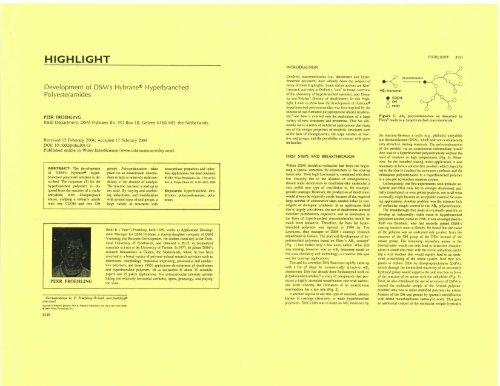
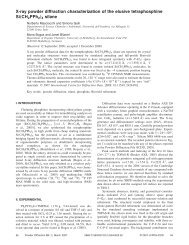
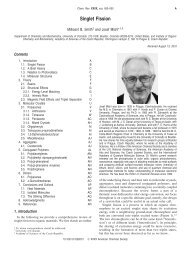
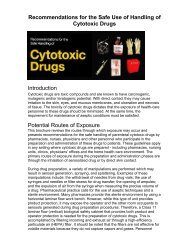
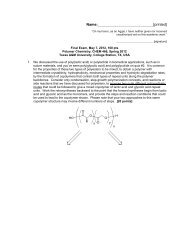

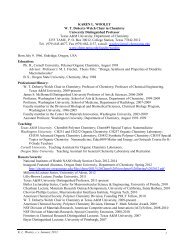
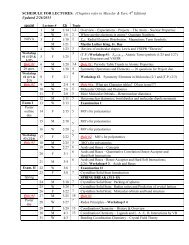
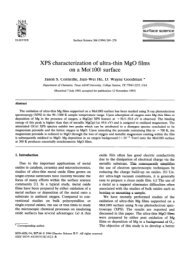
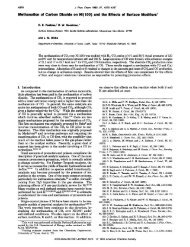
![Radical salts of TTF derivatives with the metal–metal bonded [Re2Cl8]](https://img.yumpu.com/10115211/1/190x253/radical-salts-of-ttf-derivatives-with-the-metal-metal-bonded-re2cl8.jpg?quality=85)


